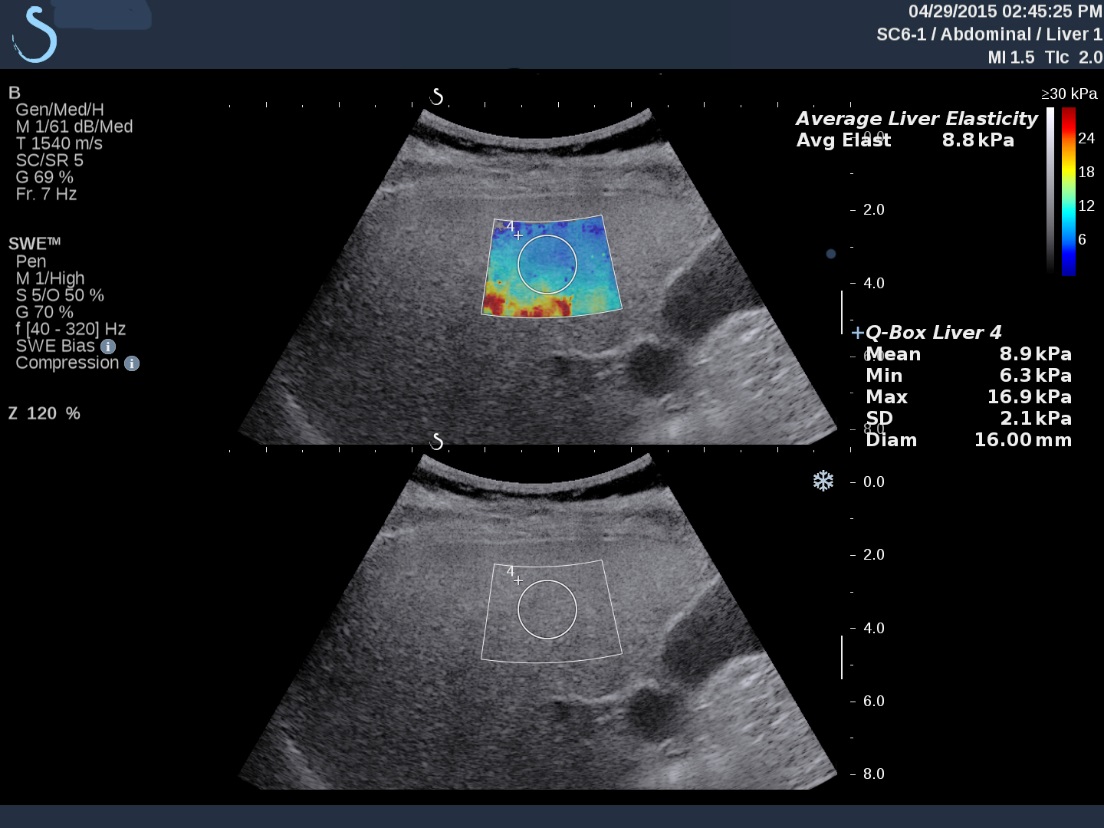Shearwave Elastography for Evaluating the Liver: Developments
By Dr. James Trotter, Baylor University Medical Ctr.
Posted on 27 Oct 2015
According to the Centers for Disease Control and Prevention, approximately 2.7 million persons in the United States have chronic HCV infection. Assessing the degree of liver damage from the virus is an important step for patients who have a hepatitis C diagnosis, as the results of the assessment will contribute to decisions about treatment. ShearWave Elastography (SWE) offers a noninvasive alternative to biopsy for evaluating liver fibrosis, monitoring the disease, and following up after treatment. At each of these stages, using SWE is a cost-effective way to help avoid biopsy while gleaning the necessary information quickly and without complications (including pain and discomfort for the patient).Posted on 27 Oct 2015
The technology

Image: A patient demonstrates a F2/F3 Fibrosis of the Liver with ShearWave Elastography after treatment (Photo courtesy of Dr. James Trotter, Baylor University Medical Center of Dallas).
Rise in demand
Studies have demonstrated the effectiveness of SWE for applications including breast imaging, imaging of the thyroid and prostate, and, more recently, in MSK diagnosis and monitoring as well. The clinical advantages of SWE for evaluating the liver have been the subject of larger studies over more time. These studies constitute a body of evidence that the World Federation for Ultrasound in Medicine and Biology (WFUMB) used, along with practical advice from its contributing radiologist authors, to inform their chapter in the Guidelines and Recommendations for Clinical Use of Ultrasound Elastography (2015) on the use of elastography to assess and manage liver diseases. These Guidelines are timely in relation to two factors: the rise of liver disease globally, and the advances in treatment for hepatitis C specifically.
Newly developed oral medications for hepatitis C are simpler to take, work more quickly, have fewer side effects, and have dramatically improved outcomes: with the new treatments, approximately 90% of hepatitis C patients are cured of the virus. The high cost of these oral medications remains an issue. Still, their efficacy and greatly reduced side effects have simplified the decision to treat the disease, which used to be a complex weighing of trade-offs for hepatologists. In 2014 the Centers for Medicaid and Medicare Services (CMS) made the determination to cover HCV screenings for patients at “high risk” for the disease, increasing efforts to uncover asymptomatic cases before they do damage. Greater outreach about and surveillance of the disease have thus dovetailed with the advances in the available medications. The ease of exam, accuracy of the results, and noninvasive nature of SWE make it a highly useful tool for evaluation in this new landscape.
Biopsies vs. SWE
While biopsies of the liver do not carry large risks of morbidity (and pose even less risk of mortality), they are costly, time-consuming, and their common complications are still burdensome. Over 25% of patients undergoing biopsy experience pain, and the procedures take several hours. An SWE scan is painless and can be done in less than two minutes in a radiologist’s office. Further, SWE can sometimes be used to circumvent biopsy’s sampling limitations; ultrasound-guided imaging technology can help zero in on areas of interest in real time rather than risk the need for follow-ups due to sampling variability or error (the liver is a large organ). Eliminating additional biopsies decreases the patient’s time in the clinic, which can direct resources to those who need them and improve clinical throughput.
SWE for follow-up
Even with 90% of hepatitis C patients being cured of the virus, the need for follow-up persists. The progress of those patients must be established, which in the past also required biopsies. SWE can frequently substitute for this traditional use of biopsy, too. Additionally, with some of the more legible displays, SWE can visually demonstrate to patients the progress they’ve made. Comparing a current scan with one called up from an earlier visit can thus inform and educate the patient about their health.
i "http://www.cdc.gov/hepatitis/hcv/cfaq.htm"
ii "http://www.ncbi.nlm.nih.gov/pubmed/25800942"
iii "http://www.niaid.nih.gov/news/newsreleases/2015/Pages/HepatitisCTripleDrug.aspx"
iv "https://www.cms.gov/medicare-coverage-database/details/nca-decision-memo.aspx?NCAId=272"
v "http://hcvadvocate.org/hepatitis/factsheets_pdf/Biopsy.pdf"
Related Links:
Baylor University Medical Center of Dallas














